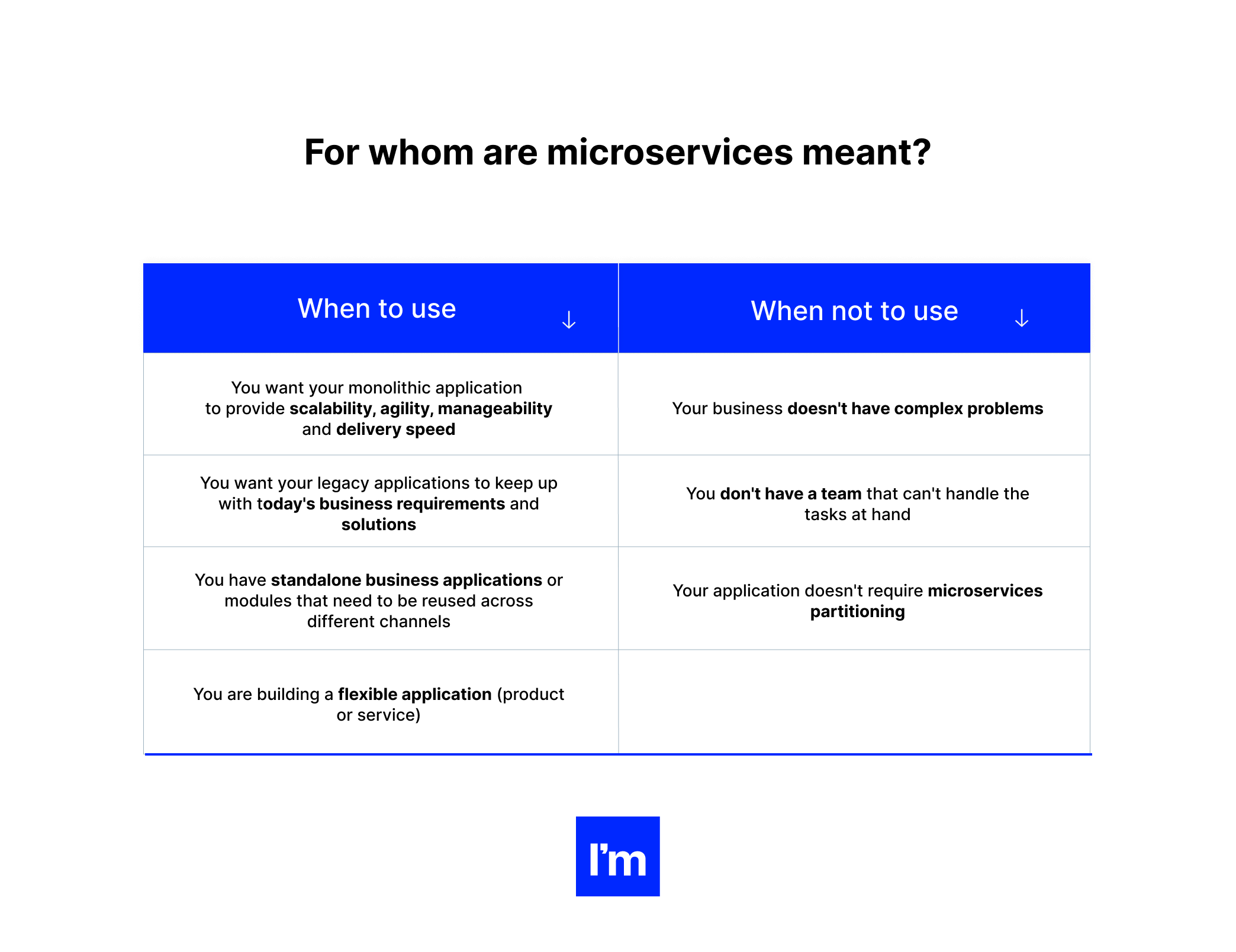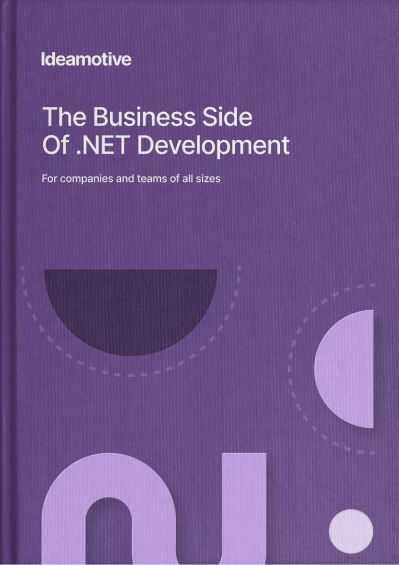Building Microservices in .NET: Business Guide
Nov 18, 202124 min read

Miłosz Kaczorowski
Co-founder at Ideamotive. Technological advisor and software consultant.
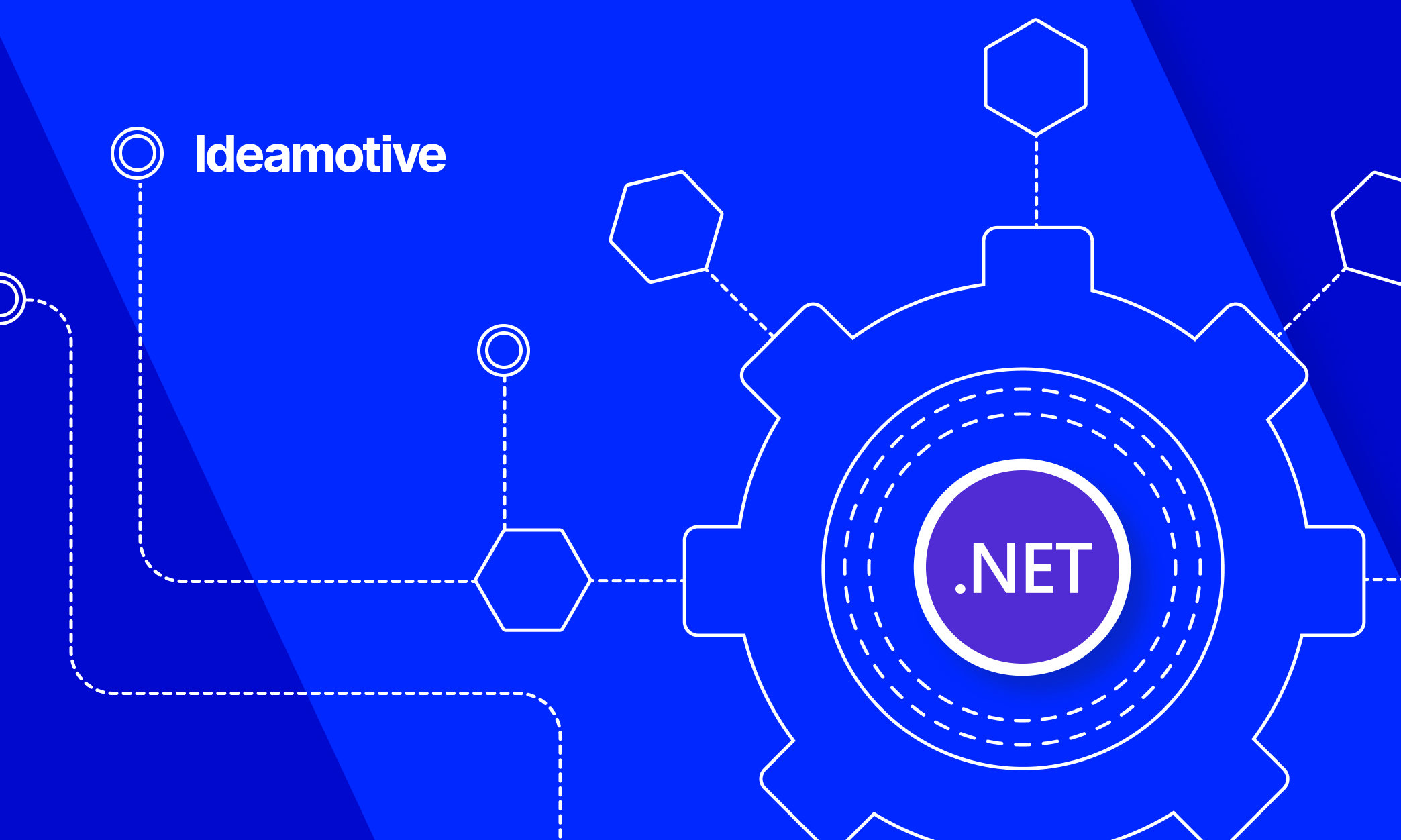
The traditional monolithic style application architecture has combined all of its functionality into one service. This caused great difficulty in deploying new features as it would require long downtime, which would reduce the ability to update the application. Scaling such applications is expensive because we have to scale the entire application, even if only the particular service receives a lot of traffic.
The adoption of the cloud has revolutionized the way we design, architecture, and deploy our applications. Helped in faster deployments, improved availability, scalability on demand, and faster time to market.
So here comes a microservices-based application, which is an architecture that aims to create small, isolated services that can be deployed and scaled independently of each other, increasing flexibility.
Find more about it below!
What are microservices?
Microservices - also known as microservice architecture - is an architectural style that structures an application as a collection of services. Easy to maintain and test. Loosely connected. Self-deployment capability. Organized around business opportunities.
The idea behind microservices is to focus on creating separate services that do the same thing well.
In simple terms, microservices are an approach to solving a large or complex business problem using a set of smaller and simpler services that work together; microservice launches its own unique process that contributes to the overarching business goal.
What is microservices architecture .NET?
Again, microservices architecture is an approach to building a server application as a collection of small services. Each service should run in its own process and interact with other services using protocols such as HTTP / HTTPS, WebSockets, etc. Any part of this framework (means a service) should be designed as a stand-alone unit that can be deployed independently. Each microservice must have its own associated domain data model and domain logic and can be based on a variety of storage technologies. By the way, it can be written in different programming languages.
The key to developing microservices is to create loosely coupled services that enable each service in an application to be independently deployed, scaled, and developed. If we are talking about the size of microservices, we should try to make them as small as possible, but leave them with a minimum of direct dependencies on other microservices. It provides long-term flexibility, scalability, and better future maintainability.
Building a granular architecture based on microservices provides continuous integration (CI) and continuous delivery (CD) capabilities. This makes it easy to integrate new features into applications that are already working. You can completely change one of the microservices to implement new functionality, or even break that service, without damaging the entire system you built.
Finally, you can add unit tests to each microservice, and this will make it easy to detect any problems or bugs in your system before they go into production. In this case, there is no need to check the entire application, it is enough to debug a small part of the code - the current microservice.
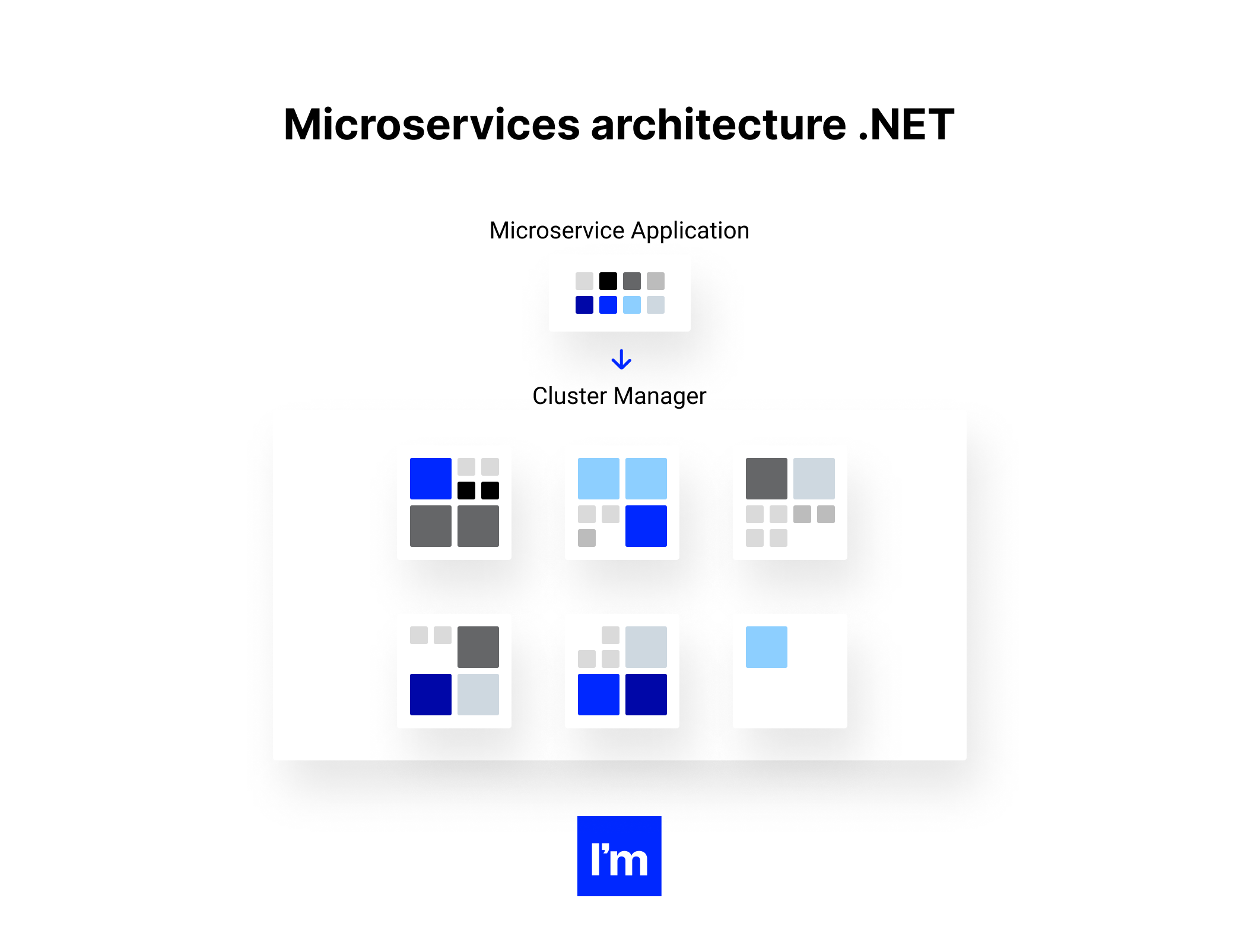
Successfully building a fully functional microservices application and deploying it on a specific platform for microservices management means that you will gain some benefits such as cost-effectiveness, scalability, and 24/7 availability. Maintaining the health of microservices can be achieved by moving instances to healthy virtual machines or platform servers. So when the software or hardware they run on fails or needs to be restarted for updates, the system automatically moves them to a safe place where these microservices can continue to run successfully.
By the way, microservices can be scaled in the same way by simply copying the service to a new virtual machine and launching another instance.
Guiding principle of microservices
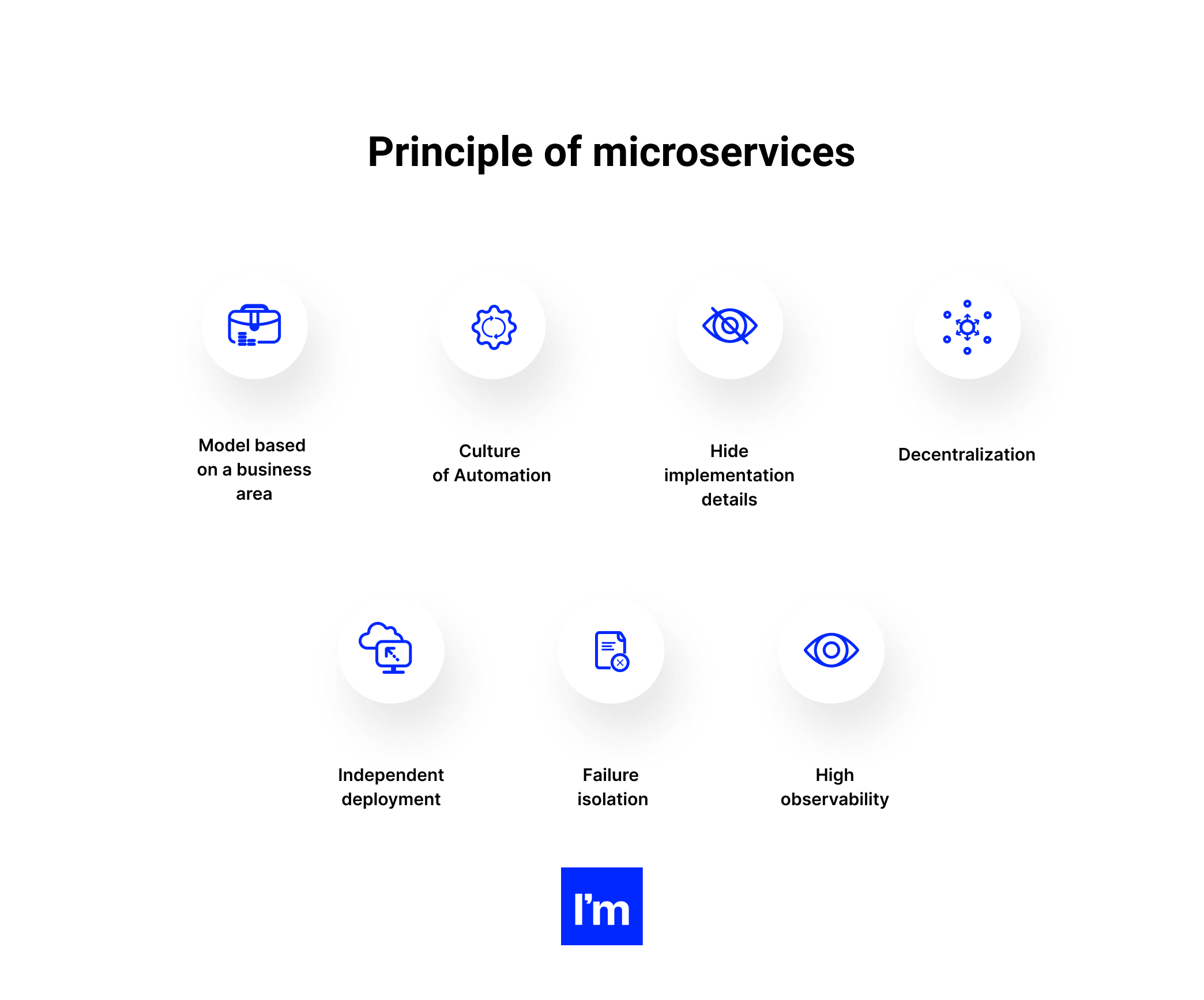
The model is based on a business area
The architecture of microservices allows you to divide the capabilities of the system into different domains. Each domain will focus on one thing and its associated logic, and can easily upgrade independently to the next version, as well as independently scale as required.
Culture of Automation
Because we build, test, deploy, and track each service separately, and the number of deployment units is increasing compared to a monolithic architecture, we must follow the culture of automation, creating it for continuous integration and continuous delivery.
Hide implementation details
Microservices should be designed so as not to reveal internal details; neither the technical implementation nor the business rules that govern it. This will reduce interconnectivity and help make changes and improvements without affecting the overall architecture.
Decentralization
In traditional monolithic implementations, the software is designed to use a single database with different tables, and microservices are designed to manage their own database.
Independent deployment
To take full advantage of the architecture, microservices must be deployed independently. If you are unable to do this, check the application for any links and fix them.
Failure isolation
The impact of a failure is less in a microservices architecture compared to a monolithic type because it will only affect those specific services and related ones while other services can continue to run. Linked services should handle scenarios such as when the dependent is unresponsive or slow.
High observability
Services should collect as much information as possible to analyze what is happening inside each of them, for example, log events and statistics.
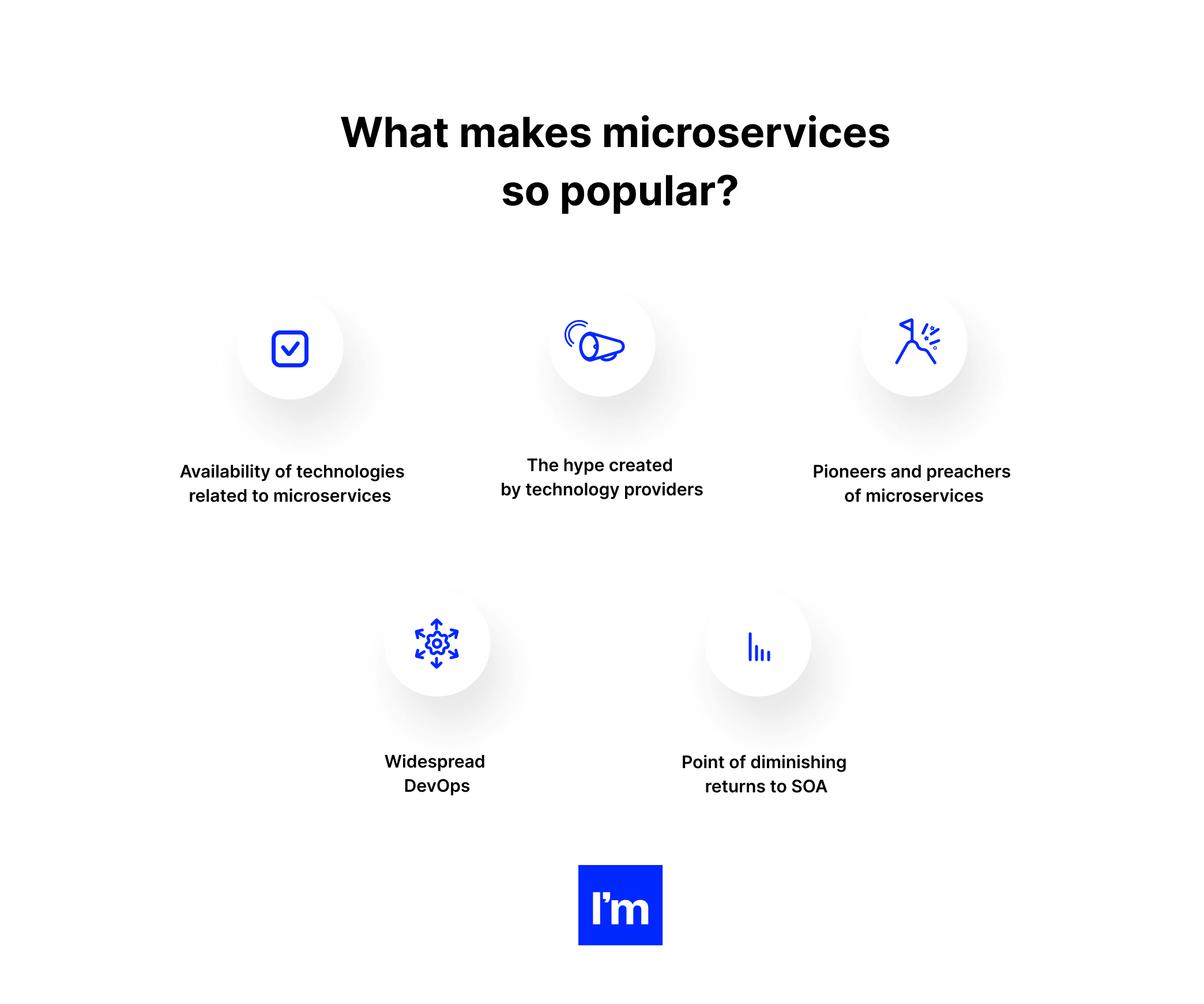
#1. Availability of technologies related to microservices
Traditional technology stacks are not suitable for implementing microservices architecture. Anyone interested in microservices will tell you that "microservices are NOW made possible by the advent of Docker containers."
We would agree with this statement, but at the same time, we would say that we must give credit to PaaS technologies as well. Recently, we've seen several large enterprises invest in PaaS solutions with the intention of adopting a microservices architecture style. For the successful implementation of microservices, it is necessary to empower the developer (team) of microservices.
Both Docker container technology and PaaS offerings have allowed technology groups the freedom to use what makes sense for their applications, and that, too, without going through legacy, bureaucratic IT delivery processes.
#2. Point of diminishing returns to SOA
Over the past decade, enterprises have invested millions in software development based on their Service Oriented Architecture (SOA) programs. In this long decade of SOA implementation, enterprises have developed skills, processes, and platforms (such as ESBs). Many such enterprises have reached the point where they have lost control of the services on these SOA platforms (ESBs), and while the skills to create and manage services are there, the flexibility expected by stakeholders (customer, business) is not achievable due to the complex and monolithic nature of the services built on these SOA platforms.
In other words, enterprises have reached a point of diminishing returns from SOA. Microservices are viewed as a next-generation service architecture that removes pain points that arise in the current state of SOA.
Implementing the microservices (and technologies) pattern on top of SOA is expected to enable development teams to realize the digital ambitions of the enterprise.
#3. Pioneers and preachers of microservices
The success of Netflix and Amazon in microservices is one of the most talked-about examples of how real businesses are taking advantage of this new architectural pattern. These businesses have not only adopted microservices practices but also shared their knowledge and even tools with the tech community. Their practical ideas have increased the credibility of the tech community. In addition, the tools created by these businesses have identified gaps that need to be filled with automation tools.
#4. Widespread DevOps
DevOps is required to successfully implement microservices. Almost every client we work with has a DevOps program. There are many tools and technologies available to businesses today to build continuous integration/test/delivery pipelines. This DevOps maturity fosters greater confidence among IT teams in their ability to build and manage microservices-based applications.
#5. The hype created by technology providers
A common theme across modern conferences is microservices and how technologies offered by a vendor (sponsor) support the creation and management of microservices.
One observation we made during these conferences was that any session with microservices in the title was sold out. These days, tech vendor blogs are full of advice on how to build and manage microservices with their products.
Obviously, all of this multi-vendor marketing effort is definitely driving IT decision-makers to consider adopting microservices.
As a wrap-up - O'Reilly's 2020 Microservices Implementation Report shows 92% of organizations succeed with microservices.
How to approach building microservices in .NET? What roles and resources are needed?
As our previous chapter has shown, there is a lot to consider when investing in a .NET microservices architecture. Another consideration, so fundamental that it's easy to overlook, is not whether you can create a microservice, but how you should be doing it from a business perspective.
Since this decision is very much affecting all stakeholders in the company, we prepared this chapter for the product owners and PMs who not only lead the engineering team towards their technical vision, but also those who interact with the rest of the business. This is a multifaceted question, so let's dive deeper into it.
Human resources
Now, let’s proceed with hiring the manpower. As you know, hiring highly-experienced .NET developers is a) difficult; b) a long-lasting process.
Moreover, each microservice itself acts as an independent application, so teams must do that too.
Form separate teams to work with different microservices. It also requires such teams to have the necessary skills and tools to independently develop, deploy, and manage a particular service. Teams must be versatile and large enough to carry out their operations autonomously without wasting time on communication.
Choose developers with a strong technical background
While the specific technology stack may differ depending on the existing infrastructure, an excellent .NET microservice developer must have certain qualifications. Here is an example of such a qualification from intermediate to a senior specialist:
- Knows the required programming language (.NET in our case);
- Understanding of DDD principles;
- Have a solid understanding of RESTful services, event-driven development, simple message buses, event streams.
- Experience in inter-system communication (REST, GraphQL, SOAP, etc.).
- Cloud preferred: AWS or other cloud providers, Docker, Kubernetes (EKS), RDS, S3.
- Previous experience with serverless architecture would be a bonus.
- Leaders and executives need knowledge of systems engineering, software architecture, and the fundamental design principles that underpin a scalable and secure application.
- Experience with agile processes (Scrum, Kanban, etc.)
- In addition, for small and medium-sized projects that do not have a dedicated DevOps team, hands-on experience in developing and deploying microservices solutions in the cloud will be a huge advantage.
Choose developers with excellent interpersonal skills
And while finding developers with a specific skill set, you also have to remember that they must have certain soft skills to be effective as microservice developers.
- Strong analytical and problem-solving skills. The ability to point out, analyze and solve a problem independently helps developers work more efficiently;
- Commitment to lifelong learning. Microservices allow you to introduce new features or introduce new technologies almost instantly. Thus, developers must be prepared to learn and quickly use this knowledge in their work.
- Upper-intermediate English (at least). If you're outsourcing microservice development, good English is a must. Working with microservices requires active interaction between developers, architects, business analysts, and other participants in the process.
The next question is, how many developers should you hire? Let's see!
Team structure
Understanding what happens in the transition from monolith to microservices is critical to understanding how processes work and how teams are built.
So, you start with an existing legacy application, which is usually huge.
- The first stage is decomposition. You divide your existing infrastructure into modules or parts. You still keep all relationships within the code but check for duplicate code. This step helps make your code more stable, leaner, and easier to maintain.
- The second stage is called denouement. In simple terms, you are breaking existing connections, turning your modules into independent microservices. It helps to simplify the management of parts of the application (maintenance, replacement, etc.)
Therefore, instead of a large application, developers work with a service that has a narrow function and a strict place in the business process.
How do these changes affect the workload of microservices developers, and what roles are critical to effective microservice development? What should a microservices developer know?
Microservice developers: roles and responsibilities
The typical team composition resembles that of traditional software development. However, there is a slight difference in roles when working with microservices.
Software architect
When developing microservices, the software architect (SA) is responsible for developing the microservices application. SA must not only plan for the division and decomposition of the monolith but also understand the needs of a specific business area and map microservices to the processes in the company. The architect is also responsible for choosing the appropriate methodology and technology for the event store, service registry, service discovery, service containers, and their implementation. This expert also selects the most appropriate integration methods such as API gateways for service registry, throttling, orchestration, etc.
The Architect also acts as a Single Point of Truth (SPOT) regarding questions, requirements, and business logic, as well as an overall roadmap.
Product team
This team usually consists of a product owner, product managers, designers and business analysts whose job is to translate business needs into technical requirements. They are also responsible for keeping development teams informed of business needs and managing budgets in line with current needs.
Development team
To be successful, each team must be responsible for the end-to-end development of one or two microservices. Any team should be small (5 to 9 people), autonomous, and loosely connected. The smaller your services, the better the capabilities are achieved (including maintainability, testability, and deployability). If you follow Agile, the team will include Scrum Master, Developers, and QA Engineers.
DevOps/infrastructure team
For a small project, one DevOps expert may be sufficient. However, if we are talking about medium to large projects like ERP, you may need a team of infrastructure experts. They not only take care of the CI/CD, but they also manage things like the cost of the environment.
DBA
Depending on the type and size of projects and system load, you may need the services of a database administrator.
Thus, by moving from a monolith, you are configuring your developers for the microservices with which they will work.
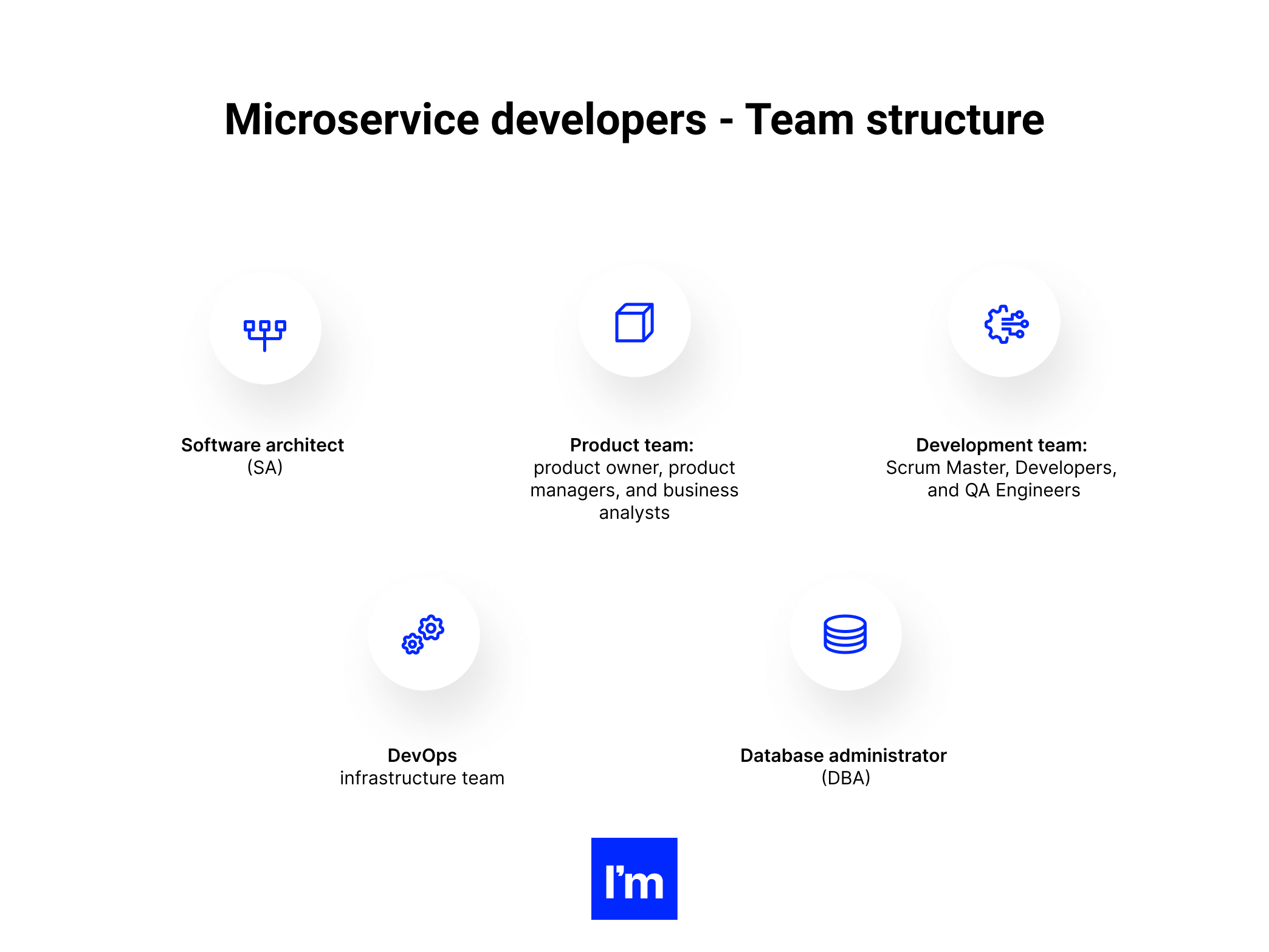
Update scale
The main aspect of determining the cost of developing microservices applications is determining the scope of the upgrade. Moreover, it is always best to start small because it will be cheap and will allow you to check if the update is working or not. Starting small will give you a clear idea of how much a development phase will cost. There are many tools out there that effectively keep costs down and stay within budget.
Maintenance costs
After your team has created a microservice, it is now your child. It is your responsibility to take care of it and keep it in good working order. As with any software, you need to troubleshoot any errors and issues that arise.
In addition to maintaining the system, your team is also responsible for making any necessary improvements as needed. If your service has a marketing function, the marketing team will want to add specific functionality to the service so that they can complete their tasks.
But the fulfillment of these responsibilities depends on the availability of sufficient capacity to do so. Software maintenance accounts for 75 percent of the total cost of ownership, which means that a significant portion of your developers' time is spent on maintenance.
In its simplest definition, the hidden cost of .NET Core microservices is money spent maintaining a more dispersed system, and can be broken down into several key areas:
- DevOps Team. You need a large group of people to build a complex ecosystem, which means the cost of getting started can be higher than with a monolith.
- Special Forces Team. You must have several people who will constantly monitor and respond to any problems.
- Double the cost of change. Because it is broken down into highly granular microservices, even minor change requests may require you to change a number of services.
- Common Sourcing Mistakes. Taking responsibility for the wrong types of services that do not provide sufficient business value.
When to use microservices
Determining whether to use
Any hype is accompanied by an equal degree of euphoria and disappointment. This is mainly due to one thing: join the stretcher just because it's trending.
It's not a good idea to start with something just because your competitors are doing it. Your business should include strategies and frameworks that match its needs. This is why you should stop for a moment and consider if you really need microservices.
To help you get started, ask yourself the following questions.
- Do you have a complete understanding of what microservices are and how they can affect your development activities?
- Is your business mature enough to implement microservices?
- How strong is your application infrastructure practice?
- Do you have a proven Agile or DevOps practice?
- Is your data management team qualified enough to support registration? If they don't, they will only slow down what should have been a quick process.
- Is your product at the core of your business model?
- What are your goals and vision for scaling? The architecture is designed with scalability in mind and is only ideal if you have a well-thought-out plan for expanding both your product/service and your market.
- Has your business model been tested?
If your answers convince you - regardless of the side - you will be able to make more informed decisions.
To keep things simple, we've put together a few pointers to help you understand when you should and shouldn't use microservices.
Use microservices when...
As a good starting point, these might be some of the ideal situations where you might prefer microservices to their monolithic counterparts:
- If you want your monolithic application to provide scalability, agility, manageability, and delivery speed
- When you need to rewrite legacy applications in modern programming languages or technical stacks to keep up with today's business requirements and solutions.
- When you have standalone business applications or modules that need to be reused across different channels: login services, search parameters, authentication tools, and more are good examples.
- If you are building a flexible application (product or service) that requires fast delivery, innovation, and more.
Don’t use microservices when...
Contino co-founder and CTO Benjamin Wootton says microservices aren't a free lunch. This means they are not for everyone. Since its inception and the fact that Netflix kind of romanticized microservices by claiming that there are over 700 microservices running on the platform, companies have been happy to incorporate them into their businesses.
But what was most overlooked was that the success stories mostly came from product companies that went through many iterations and models before they had a product ready to go to market. This architecture became suitable for them after they realized the problem they were trying to solve and were successful in it. This is why it is so important to understand if you need microservices for your business.
Here are several factors as a starting point:
- Microservices are about solving complex problems, and if your business doesn't have complex problems, know that you don't have a system that can handle the complexities of microservices.
- Using microservices can backfire if you don't have a team that can't handle the tasks at hand. This will only lead to a delay in delivery.
- Implementing microservices can also get in the way. If your application doesn't require microservices partitioning, then you don't need to. There is no absolute need to split all applications into microservices. There are also simple ones in nature and functionality.
Have a complete understanding of the issues involved, in addition to the benefits, because they provide more information on whether you should start implementing this architecture. If you can manage to see the right value for your product with microservices, go for it.
Pros and cons of building microservices in .NET
Any architectural style has trade-offs: strengths and weaknesses that we must assess according to the context in which it is used. This certainly applies to microservices. While this is a useful architecture in many, it is actually better to use a monolith in most situations.
Please, see through the next chapter to find out challenges you could miss before.
Benefits of .NET microservices
- Services can be written in different programming languages and can be accessed using any framework.
- Independently develop, deploy, redeploy, version, and scale component services in seconds without compromising application integrity.
- Better fault isolation allows other services to run even if one of them crashes.
- Zero downtime updates.
- Services can be from different servers or even from different data centers.
- Interaction with other services using a well-defined protocol.
- Monitoring, collecting and reporting health diagnostics.
- Reliable and self-healing.
- Supports continuous integration and delivery.
- Easily transfer knowledge to a new team member.
- Easily integrates with third parties.
Challenges of .NET microservices
- Additional complexity for the implementation of the interprocess communication mechanism between services.
- Writing automated tests that include multiple services is challenging, and it can be difficult to create a consistent test environment.
- A high level of automation is required to manage multiple instances of different types of services in a production environment.
- Everyone must manage the ultimate consistency, as maintaining string consistency becomes extremely difficult.
- Managing multiple databases and their transactions is difficult.
- Interprocess calls are slow.
- Debugging will get tricky.
- Complexity in DevOps.
- Production monitoring costs are higher.
- Official documentation overhead.
- Lack of control.
By and large, here we are comparing the benefits of .NET microservices to the ones of a monolith. So why not compare them head to head?
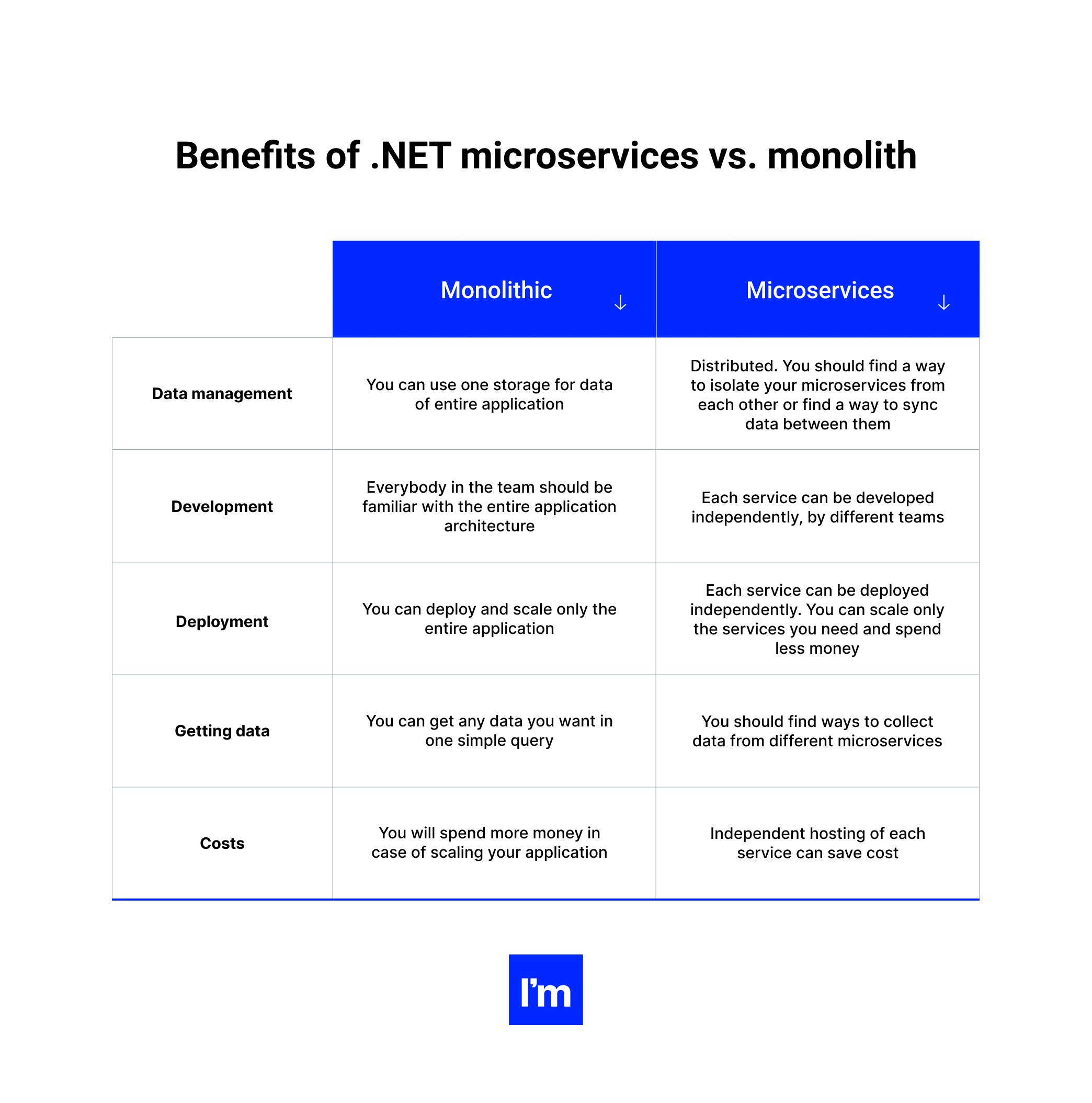
Types of microservices in .NET
Generally speaking, there are two types of microservices in .NET:
- Stateless microservices;
- Stateful microservices.
Stateless microservices
Stateless microservices are good candidates as the building blocks of a distributed system. As the name suggests, stateless microservices do not maintain a session state between requests, for example, if any instance of a service is deleted, this does not affect the overall processing logic of the service. Distributed systems prefer stateless microservices.
If we look at the diagram, the customer makes a product request through the ORDER service, and the internal ORDER service checks the product status through the INVENTORY service.
Stateless means that each request is executed independently of previous or future requests. A single call to get product details will return the same result regardless of previous context or queries. If one call to the ORDER service fails, it shouldn't stop processing the entire business. Other instances of microservices must be running to complete the task.
Stateful microservices
Stateful microservices store session information in code. When two or more microservices communicate, they maintain the state of the service request.
In the real world, stateless services are a good choice, but there are several use cases where you need to store state information. If we think of a simple example, transactions that require multiple rounds of database access require statefulness.
To learn more about stateful microservices, go to Overview of Azure Service Fabric - Azure Service Fabric
Common differences in stateful and stateless application processing
- Stateless applications only have one function or service, while stateful applications store databases.
- Stateless applications include web servers, print servers, or CDNs, and stateful applications include transactions such as home banking.
- A server in a stateless service handles requests based on the information passed at a time, while a server in a stateful application processes requests based on both previous and current information passed.
- In a stateless application, different servers can be used to process different information, whereas, in a stateful application, only one server is used to process all requests related to the same state information.
- Stateless applications use containerized microservices applications to render results. On the other hand, stateful applications use moving containers and volume remounting without any application or code changes.
.NET microservices - impact on the product
Being able to adapt to ever-changing markets is the only way to stay afloat and thrive as a company today, and that's why scalability is so important.
The idea of scalability is simple - the more resources, the better the performance of your enterprise. You can apply it to your company, where more resources mean corresponding growth in sales, or to software architecture, where it represents the ability to grow and evolve with increased demand.
Microservices architecture is all about planning ahead and making sure you're ready for the future. What exactly are the potential benefits of microservices and how do they implement scalability? We're here to answer!
ASP.NET Core identity microservice benefits for business
The main reason for building a microservices architecture is the desire to develop a certain line of business in isolation from the rest. This approach allows you to add new functions to a given module with minimal impact on the rest of the system. The idea is to gain independence in development and deployment. Since microservices are organized according to business requirements, the development team is more familiar with user expectations and can understand the business perspective. The better the level of understanding, the better the alignment with the business.
Think of microservices architecture as a stand-alone philosophy as opposed to a monolithic architecture approach. In a monolithic architecture, an application is viewed as a single whole, consisting of many elements that serve a single purpose. Microservices architecture breaks the link between these elements, making each of them an independent unit.
Microservices architecture is by definition lightweight. By dividing each component of the application into a separate microservice, we can focus on the specific business needs that each module is responsible for. These independent modules interact with each other, working as a collective of units, and not as a single monolith. Since your business processes are then decoupled, it is easier to scale the most critical at any time than the entire application.
Achieving scalability for your business
Efficiency is paramount in microservice ecosystems. Achieving the efficiency and scalability of our architecture, in which tasks are sometimes spread across dozens (if not hundreds) of small services, can be very difficult.
While focusing on the benefits of this approach, one should not forget about the problems associated with increased complexity. To achieve the desired level of architecture scalability while maintaining a fast and successful implementation, it is necessary to properly organize the workflow and development process. Success is impossible without proper planning and organization. You can have the best programmers, but if you don't manage it properly, the project will not be successful.
Therefore, let’s first see the development process in more detail.
How the product is developed
You should know that moving from a monolith to a microservices ecosystem can be an epic journey. There are a few things you need to do to make things go well.
First of all, identify the business opportunities that you want to turn into microservices. Make sure each microservice encapsulates specific business capabilities. Business opportunities are what a business does in a specific area to fulfill its goals and responsibilities.
Now let's break it down into more detailed steps.
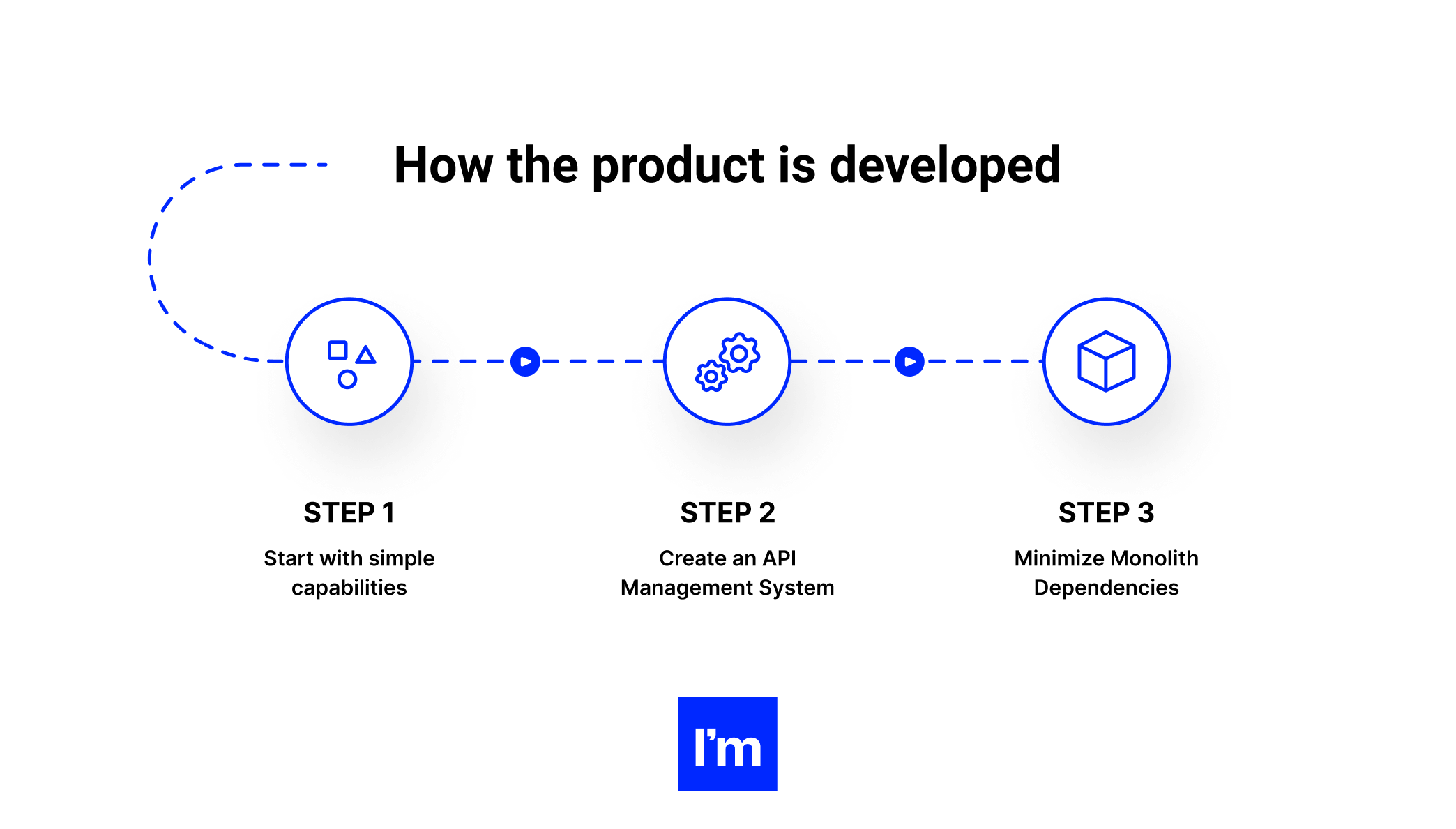
Step 1. Start with simple capabilities
Get started with business capabilities that can be easily decoupled from a monolithic application. It also allows your DevOps team to set up the required deployment environment and continuous delivery pipelines.
Here are some initial examples: split the user authentication service or "client profile". These are edge services that can be easily decoupled.
Step 2. Create an API Management System
Since you will be dealing with a lot of APIs, start working on your API Management System. This often involves setting up a service network to act as a dedicated infrastructure layer to run a fast, reliable, and secure microservice network.
Meshing often starts with container orchestration systems such as Kubernetes to provide a higher level of abstraction to the deployment infrastructure.
Step 3. Minimize Monolith Dependencies
Also, minimize the dependencies of newly created microservices on the monolith. The microservice must be independent and only accept service requests through open API endpoints. If you strictly follow this rule, you will end up with a monolith that depends on the capabilities of the microservices you create, and not vice versa.
Hint: Share Deeply Integrated Capabilities Early
To accelerate the transition to microservices, it is best to decouple deeply integrated capabilities from a monolithic application. When deeply integrated capabilities remain in the monolith, it limits further migration to microservices. This is because there will always be this dependence on the monolith for a particular opportunity.
To be able to evolve, a team needs to identify a sticky opportunity, break it down into well-defined domain concepts, and then break those domain concepts into discrete microservices.
How can microservices impact business growth?
The microservices architecture idea is the result of years of evolution in IT industry best practices. As companies strive to improve the customer experience, it seems natural to decide to separate each process into a separate unit - that way you can ensure that every component of your application performs at its best.
Since your business functions are divided into separate entities, each of them can be created, tested, and run independently. This also means that they can be changed in isolation, without disrupting your business operations. Consistent or even increased delivery speed while remaining flexible in terms of implementing change is what every CEO is looking for, and the microservices architecture guarantees it.
Check out more research on the topic!
Optimizing costs with microservices and cloud services
By implementing a microservices application, the company is building a scalable infrastructure. Adding on-demand and pay-per-use billing to this increases operational efficiency and optimizes costs. Cloud microservices simplify the delivery of your applications and help products go to market faster.
Boost scalability with microservices architecture
Now that you know how effective .NET microservices are for growing a company, let's summarize their direct benefits:
- They improve scalability by allowing each component to scale independently.
- They make applications much easier to understand by breaking them down into small pieces.
- They adapt to new technologies
Remember - simpler systems often don't need to be broken down into microservices, as this will only lead to confusion. However, for more complex systems, a microservice architecture can potentially be a good option.
Talent pool and language popularity
Microsoft's desire to provide developers with a single platform to solve any problem was realized with the help of .NET. The .NET platform has been supporting web, desktop, and mobile apps for both startups and enterprises for a couple of decades.
There is no doubt that .NET plays a central role in the software development industry. The popularity of .NET in the developer community is a fact. You can measure this by the number of open-source projects around the world and by the presence of C# in the top 5 most popular programming languages. Its popularity is set to grow even more, especially since its latest release (.NET 6), which revolutionized the industry by creating the concept of universal software development.

Today, according to many assumptions, ASP.NET developers have about 7-8 million people in their squad. Most of them are C# developers.
Talking about С Sharp, why not check out .NET vs C# comparison?
Even though C# is considered the primary programming language for .NET, you can use many other languages of your choice. However, not all of them are well-aware of microservice architecture development.
Therefore, we recommend you turn to a vetted tech talent marketplace. In doing so you’ll be sure to hire only seasoned web developers.
Is .NET good for microservices?
The advent of ASP.NET Core has helped developers build cross-platform microservices with .NET on a variety of operating systems with easy cloud deployment.
There are many reasons that ASP.NET Core development is loved by one and all:
- its open-source nature,
- good for implementing high-performance solutions,
- cross-platform runtime support,
- faster development,
- cloud configuration,
- many more.
ASP.NET, the .NET platform for web development, makes it easy to create APIs that become microservices. It includes built-in support for building and deploying microservices using Docker containers.
.NET comes with APIs that can simply consume microservices from any application you have developed, including desktop, mobile, internet, games, etc.
If you have an application, you can start implementing .NET microservices without changing it completely. The initial setup for .NET Docker images is already done and is available on the Docker Hub, which will help you focus on building microservices only.
.NET microservices architecture allows technology to be compiled between each service. This way you can use .NET for a specific part of your application without embedding it all over the place.
You can mix .NET microservices with applications written in Java, Node JS, or any other language (feel free to check, what’s better: .NET vs Java).
This allows for a gradual transition to the underlying .NET technology for new microservices that work in conjunction with other microservices and services built with other technologies. Likewise, .NET microservices can run on all leading cloud platforms.
The fundamental point of view on which microservices and ASP.NET Core are based is quite comparable to each other. Since .NET was one of the first to create applications based on the Simple Object Access Protocol, its methodology is regarded as the modern microservices architecture.
Let's now take a closer look at the key attributes of ASP.NET Core development and its preferences for building microservices.
ASP.NET Core’s key qualities for building microservices
Better and faster containerization
Any ASP.NET Core application can be put into a Docker container. Even traditional software supports container technology. But the latest version of the same allows you to get higher quality images, and faster.
Kubernetes and Docker compatibility
Its Kubernetes compatibility is an optional feature in the ASP.NET Core header, so it can leverage all Kubernetes features and develop microservices efficiently. Even building microservices with Docker is an efficient option thanks to all the detailed documentation available.
Cross-platform application compatibility
ASP.NET Core supports multiple operating systems and is cross-platform technology compatible. The earlier version was limited, but now the latter is cross-platform. It is important for microservices that they are not platform or architecture-dependent.
Faster speed and higher consistency
Over time and with new versions, the latest releases of ASP.NET Core get faster, better, and more secure. Recent surveys have shown that the results of this work are getting better and better. The number of releases has increased over the past few years.
Taking a look at recent ASP.NET Core benchmarks, you'll see that its performance has only improved since its launch.
Flexibility in choosing an IDE
When building an application in a microservices environment using ASP.NET Core, developers can choose the IDE that suits them best. You don't have to choose Microsoft Visual Studio. Developers can opt for free software to build their applications on microservices.
Cloud compatible
The basic nature of ASP.NET Core supports cloud scalability. Any type of microservices built using this technology will surely run smoothly on all-important cloud services. For example, Azure is one of the cloud technologies that we recommend because it was designed specifically for the .NET community.
Modular and lightweight
The two main properties of ASP.NET Core - its modularity and lightness - are key when choosing it for developing a container-based microservice application.
Stability
In early 2017, when version 1.0 was launched, many features were still pending, support for database connectivity was weak, and .NET Core looked like a beta product with a lot of potential.
Since then, the framework has improved significantly:
- libraries like NHibernate now support ASP.NET Core,
- the performance of its modules has improved significantly,
- the platform as a whole is much better and more stable.
You can see all the release notes for each version here.
Command-line oriented
ASP.NET Core lets you build, compile, run, and deploy from the command line.
Easy to get started
By using a simple command like "dotnet new webapi" you get the foundation for your microservice.
ASP.NET Core development has established itself in the IT market and is successfully considered suitable for building microservices. There are many programming languages to choose from for building the ideal microservices architecture, but ASP.NET Core has proven to be a perfect choice. Demonstrating the value of ASP.NET Core isn't too difficult. This is a proven fact!
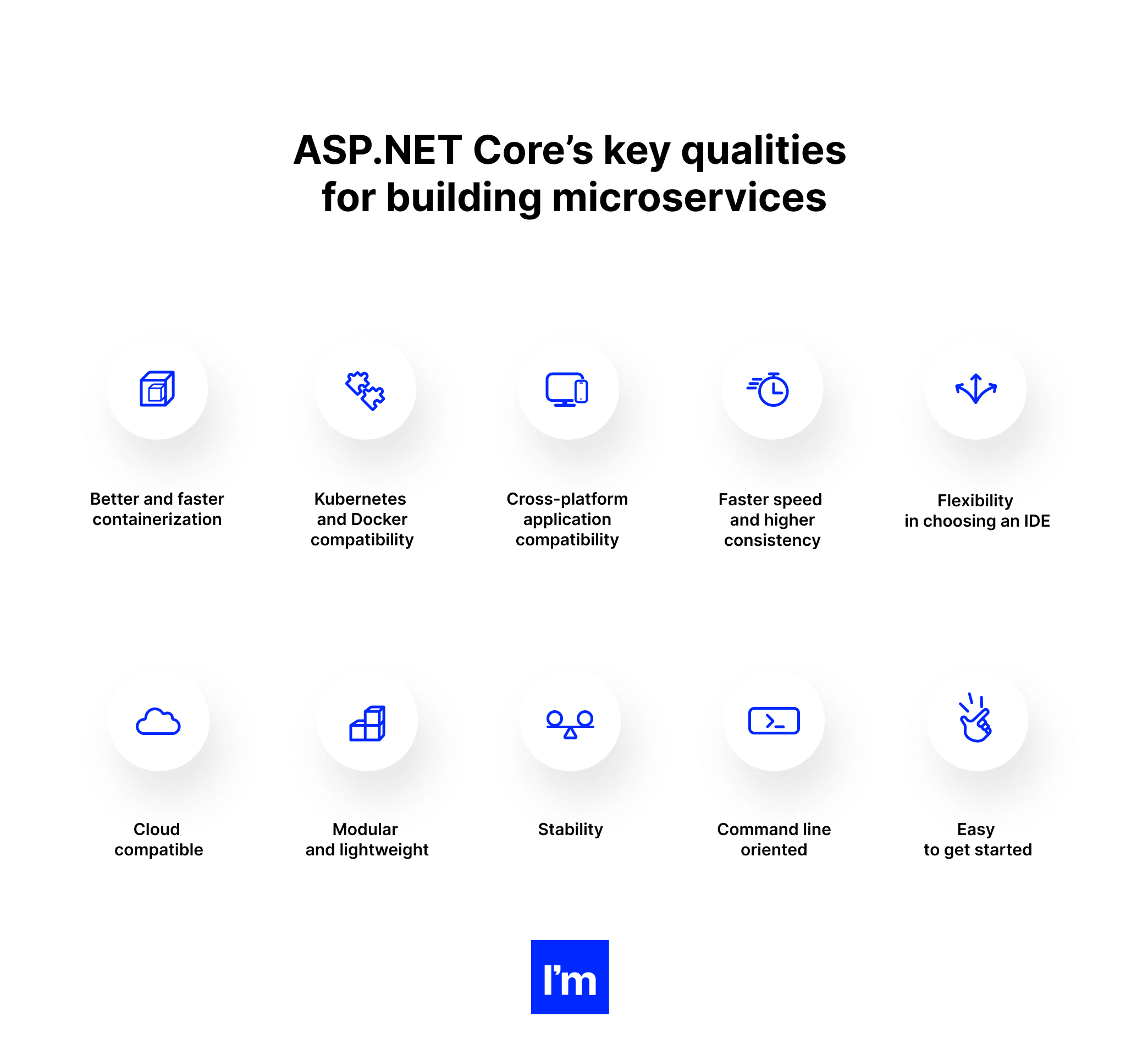
Real-life examples
Global companies like Amazon, Coca Cola or Zalando are transforming their IT infrastructures into a microservice architecture. In addition to this, they are realigning their internal organizational structures and moving their business ahead of the competition.
Most large companies, as well as startups, build their systems using monolithic architecture. They start this way because at the initial stage of projects it is much faster to create a monolith and start a business. After a while, problems arise due to the maturation of projects or the growth of fat. As the system grows, the code becomes more complex, the architecture becomes more complicated, and we need more developers to maintain it.
At the same time, we are losing speed, flexibility, and agility, making it difficult to respond to market demands.
Let’s see what companies solved their issues by turning to .NET microservice development!

When BestBuy.com ranked 10th in the top 500 online retailers, the company reached a point where even simple changes and updates to the IT system were extremely difficult and even dangerous, as the company could not effectively prepare for the peak traffic during the holidays. Their app ecosystem has gotten too complex and just stuck in place.
After that point probably the best .NET Core microservice example transformation began. The process began in 2010 with the construction of dependency graphs of interconnected modules within a monolithic platform, then the developers began to implement microservices. Best Buy used the Strangler pattern to replace the old system with microservices step by step.
The hard work on the culture has allowed many teams to gain accelerated development and freedom. Our focus has always been on learning to improve
the developer Kristen Womack said.
While the transition to microservices was difficult, Best Buy used it to restructure the organization and system to fit together and support the company's future processes.
Learn more about microservices at BestBuy.com here.

The Coca-Cola Company - 3,800 products worldwide and subsidiaries around the world - is another great microservices architecture .NET example. The company faced the challenge of connecting businesses across continents and supporting their growth.
Coca-Cola's global IT group has decided to use microservices and APIs to achieve this goal and gradually replace legacy software. In this case, rapid change will not be possible due to the many solutions implemented globally (ERP, transformations, repositories).
The company knew that there were many ways to implement microservices and, in the end, decided to move to a new architecture using the DevOps model. In it, they introduced a structure, divided into one application, with which they can solve any problems that arise in terms of speed and maneuverability.
On the other hand, GIT has created a library of reusable modules (called Anypoint Platform) organized into domains that are available to all objects in the group. With a database of ready-to-use services, projects across the entire organization and external partners can be delivered faster and at a lower cost.
Compared to our legacy integration solution, Anypoint Platform has allowed us to reduce the data flow to the Coca Cola network by 50%, and the time it takes to scale to support more freestyle machines from weeks to minutes.
- Dani Ang, Corporate Integration Architect at The Coca Cola Company.
Along with the changes in technology and architecture, Coca-Cola has focused on processes and people. The company moved from the COE model to the C4E (Center 4 Excellence) model and gained synergy through collaboration and sharing in the system.
Learn more about microservices at Coca-Cola here.
Wrap up
Moving to a microservice architecture is an innovative solution to deliver software quickly while reducing risk. This is a top priority for many future-oriented companies. When your business is ready to transition, it's important to know exactly what your application needs to deliver the quality of service, scalability, flexibility, and business success you need when all is said and done.
Analyzing the business benefits of microservices can help your enterprise/startup/scaleup identify its unique migration goals and ensure that you have the support to manage the additional complexities of moving to a container architecture.
As we work with companies to create their roadmap and goals for the transition to container architecture, we have seen incredible growth and success from a cutting-edge approach to the transition. Some of the most common business benefits include:
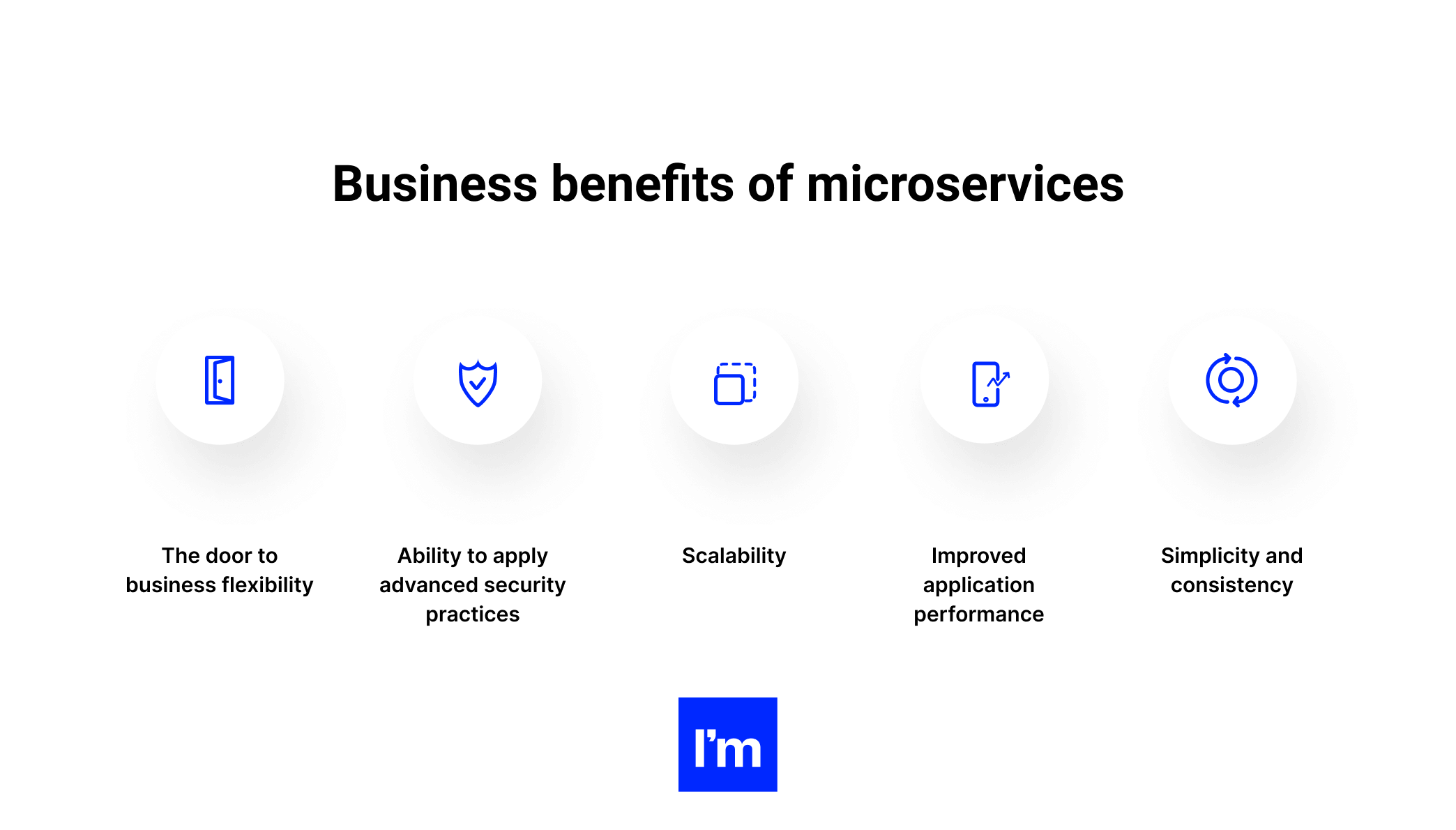
The door to business flexibility
There is a high risk of making changes to legacy applications because changing one process can negatively affect another. In contrast, with loosely coupled microservices, updates can be performed independently of the rest of the application. This then results in faster application development and versioning, so that companies can “fail quickly” and adhere to flexible product development timelines.
Ability to apply advanced security practices
In microservices, a complete understanding and visibility of network dependencies is important, as well as consistent access and security for each microservice. Leverage in-depth knowledge of container scanning and cluster networks, and apply a service mesh to ensure your environment uses every possible tool to ensure maximum security.
Scalability
Microservices can be scaled horizontally with two machines running next to each other, instead of enlarging an existing machine. This means you can zoom in and out as and when you need to, saving money and improving the user experience.
Improved application performance
If and when problems arise, it affects one small part of your application, not all. This provides the best performance for end-users and eliminates downtime while IT troubleshoots and restores service as normal.
Simplicity and consistency
Many companies are moving to containerized infrastructure due to the need to scale. When microservices are automated and templated, they are easy to manage and easy to replicate or remove. This means you have a consistent approach to scaling, orchestrating, and managing your application.
Ideamotive talents are at your service
Microservices offer clear benefits such as cost savings and faster time to market. This reduces the number of failures and provides higher availability. However, overzealousness or misdirecting the architecture of microservices can make things overly complex. This means that you will lose all of these benefits.
When moving to microservices, you need to think carefully. You may need to hire additional resources with new skills. Also, don't forget to rate your current DevOps team.
Feel like additional help is a might for the process? Turn to Ideamotive for top C/C++ developers! Need a whole team of dedicated employees? We are here to help you with every purpose!

Co-Founder of Ideamotive. Highly skilled in Ruby on Rails, JavaScript and Linux System Administration. Experienced in implementing effective web apps.
View all author postsTrending articles
21 Dazzling Examples of Mobile App UI Design to Inspire You in 2023
Michał Pruciak 7 min read
MedTech vs HealthTech vs BioTech: What Are The Differences?
Michał Pruciak 7 min read
10 Business Applications of Neural Network (With Examples!)
Michał Pruciak 4 min read
10 Irresistible Examples of Web Design Best Practices for 2023
Adam Kozłowski 7 min read
21 Amazing Examples Of React Web Development
Michał Pruciak 14 min read

Read more featured .NET publications and articles
Looking for a specific type of software development service?
Looking for .NET development experts to join your team?
There are dozens of vetted .NET professionals in our talent network.
Rated 4.8 / 5.0 by clients from various industries and locations.

